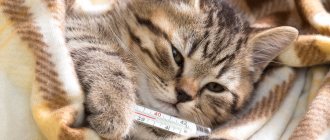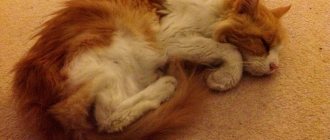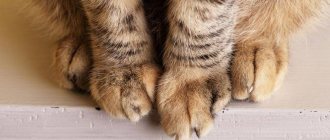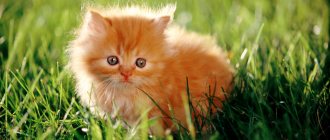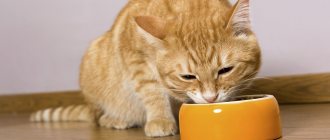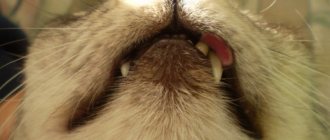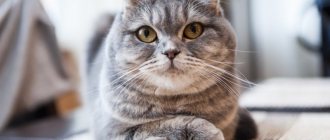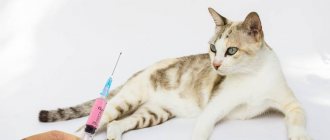Independent in nature, British Shorthair cats have strong bones, a rounded muzzle and large, expressive eyes. And their “plush” coat has become one of the many advantages of the breed. With proper care, the “British” can live 15 years or even more. But neither domestic cats nor those with access to free walks in the fresh air are 100% protected from diseases. Therefore, every owner should know what characteristics his pet has, and what should be taken as warning signs and signals for an unscheduled visit to the veterinarian.
- Diseases of the breed
- Symptoms
- Genetic diseases
- What are the most common diseases in British cats?
- Conjunctivitis
- Parasites
- Gastrointestinal diseases
How can you tell if your cat is unhealthy?
The most common sign of illness is refusal to eat. Bad hair and inflamed red eyes can also be considered symptoms of the disease. In addition, the following symptoms may occur if you feel unwell:
- labored breathing;
- cough.
If such symptoms appear, then you urgently need to take your pet to the veterinarian. Note that temperature can tell a lot about the condition of an animal. Normally, it should not exceed 39 degrees. If the readings on the thermometer are higher than normal, then there are good reasons to say that the cat is sick. If you see readings less than 37.5 on the thermometer, then you urgently need to show your pet to a doctor.
Genetic disorders
Scots and Britons are most likely to experience haemophilia and cardiomyopathy. In the first case, we are talking about poor blood clotting and increased bleeding time. Even a minor cut can cause a lot of blood loss.
As for the second disease, it is divided into:
- Hypertrophic cardiomyopathy. This type of disease, during which the walls of the heart enlarge, is more common than all others.
- Dilated cardiomyopathy. With this type, the thickness of the walls does not change, but the volume of the heart increases.
- Restrictive cardiomyopathy. During the problem, fibrosis of the heart develops - the hard muscle cannot contract as before, which leads to serious consequences.
A special disease of the British
Let's start describing diseases with the most acute and serious problem. Representatives of this breed can have two blood groups in their bodies (A and B). If you don’t plan to breed a cat, then there shouldn’t be any special questions. However, problems may arise when breeding representatives of the breed. For example, if a cat with group A is mated with a cat who has group B, then there is a chance that the offspring will have two blood types combined. After birth, kittens with this problem feel completely normal. But on the third or fifth day they may suddenly die. This phenomenon is medically called “disappearing kitten syndrome.” Why do kittens with this pathology die? The reason is the production of antibodies in the body of the mother cat. They simply do not recognize kitten blood. When interaction with breast milk occurs, cell destruction begins. DNA tests are used to identify blood type at an early age.
Prevention and vaccination
In order for your pet to be healthy, preventive maintenance should be done in a timely manner. Vaccinations are the best method of prevention. When mother's milk is no longer a source of antibodies, babies' immunity weakens and they should be vaccinated. In order for antibodies to be produced in milk, the mother cat must also be vaccinated.
Vaccinations are given to British kittens from two months of age. This procedure is repeated once a month until the Briton is one and a half years old. After reaching this age, vaccinations are given once a year. To avoid the formation of tartar, you need to accustom your pet to brushing its teeth from childhood.
Vaccinations are given according to schedule. If you have purchased a kitten, then the first thing you should do is ask the seller if any vaccinations have been done, and what the kitten may have already been sick with.
From the age of 5 months, British children need to carry out mandatory prevention of helminthiasis, infection with subcutaneous and ear mites. For this purpose, the veterinarian prescribes special medications. If the cat is weakened or pregnant, then it is contraindicated to take anthelmintics.
To avoid infections of the eye tract, wipe the eyes weekly with disks moistened with boiled water. The ears are cleaned once every two weeks with dry ear sticks.
If you carry out vaccinations in a timely manner and take preventive measures to prevent diseases, your Briton’s health will always be in perfect order.
Recommended Posts
Review of cat food or how to choose quality food
Diseases and vaccinations of Scottish Fold cats
Assortment and composition of cat food Royal Canin
Common ear sores in cats: symptoms and treatment methods
Standard and rare colors of British cats
Common and rarest colors of the French Bulldog
Hypertrophic cardiomyopathy
Continuing to describe the diseases of British cats and their symptoms, we cannot help but say that such animals have the genetic disease HCM (Hypertrophic Cardiomyopathy). “What kind of illness is this?” - you ask. This is a disruption of the heart and blood circulation due to the formation of thickening of the heart muscle. Initially, heart disease in a British cat does not manifest itself. But after a while you may notice the following signs:
- depressed state;
- dyspnea;
- fast fatiguability;
- hoarseness.
The disease is most often diagnosed in adults. Therefore, an ultrasound examination of the heart is required at the age of 1 year. Please note that this disease cannot be treated. Some representatives of the breed do not manifest the disease at all.
Breed health features
As a rule, the British cat is a hardy animal and is rarely subject to various ailments if it is fed with balanced food and regularly monitors its health. On average, a Briton lives about 15 years, but this period is greatly influenced by the characteristics of keeping a pet.
There are many factors that can both extend your cat’s life and significantly shorten it. For example, it is believed that when an animal has been castrated or sterilized, its life expectancy will be longer. In addition, such tailed friends are less likely to get cancer thanks to this procedure. If you overfeed your pet, this will not have the most favorable effect on its health.
Eye problems
What eye diseases is the British cat susceptible to? For example, conjunctivitis. What kind of disease is this? This is an inflammation of the mucous membrane of the eye. Representatives of the British breed have a special head structure. For this reason, their eyes are very vulnerable. Conjunctivitis indicates an infectious lesion. It is important to find out the reason for its appearance. The disease can occur in a British cat due to mechanical damage, allergies, or a viral disease. Regardless of the nature of the disease, you need to undergo a course of treatment. Drops and ointments are usually used topically.
Another disease of British fold cats is epiphora. The disease manifests itself as abundant discharge from the mucous membrane of the organs of vision. This disease is very common among representatives of the breed. The disease is associated with many reasons: blockage of the tear duct, inflammation of the eyelids, volvulus, unnatural structure of the tear duct, etc. Antimicrobial drugs are used for treatment.
Cause of allergy to British cats
Are there allergies to the British? Today, the list of cat proteins harmful to humans contains eight types of allergens. The proteins are numbered 1 to 8 and are named Fel(D1 – D8) accordingly. The first protein (FelD1) in most cases is the culprit in the manifestation of the disease, causing a response from the human body's immune system.
FelD1 is a protein produced primarily by the sebaceous glands of the cat's body. Found in smaller quantities in saliva, anal glands, hairs and on the skin (epithelium). Scientists believe that protein serves animals to protect the skin, mouth, and anus. For cats, this is a necessary element of life, but for people with allergies, it poses a danger.
Sometimes, when advertising a cat breed and describing its advantages, breeders emphasize that representatives of this breed cannot cause symptoms of allergic reactions in people. This opinion is substantiated by the small amount of hair in animals. Supposedly, a less furry animal produces fewer allergens. Such statements are not consistent with scientific data, since the source of the source of trouble (the FelD1 protein) is the sebaceous glands, not cat hair.
Even short-haired breeds can provoke allergic reactions. Released from the sebaceous glands, the provoking protein settles on particles of fur. When a cat sheds, the hairs scatter throughout the house, carrying the sources of the disease. The fur of cats of the British breed is short, but dense and thick; the animals shed actively. People staying indoors with cats are potential victims of allergens. The intensity of the response is determined by the characteristics of the body of a particular adult or child.
Not long ago, rumors leaked to the press: American scientists attempted to artificially breed a genetically modified cat breed without the insidious FelD1 protein. The source of the genetic material was the British Shorthair breed. The choice fell on the British, as one of the most popular breeds. The results of the experiment are unknown. The mutants have not yet reached the breeders, so it is too early to talk about the hypoallergenicity of the British Shorthair breed. British Shorthairs and Longhairs can produce allergens just as intensely as breeds with long hair or no hair at all.
Kidney diseases
There are cases when representatives of the breed are diagnosed with urolithiasis. It occurs due to impaired metabolism and poor diet. Signs of this disease in British cats are as follows:
- the animal experiences discomfort during urination;
- lack of appetite;
- the fur becomes unsightly.
Once the diagnosis is confirmed, appropriate therapy is prescribed. There are times when it is necessary to resort to surgery. Also, a sick animal requires a strict diet with medicinal drugs.
Therapeutic techniques
If any of the above symptoms appear, you should immediately take your pet to a veterinarian. A sick cat should be given complete rest, especially carefully isolated from small children. There is no need to play or tease the cat, as any sudden movement is fraught with sudden paralysis. At first, if the symptoms are not too threatening, drug treatment is practiced, the purpose of which is to stop the inflammatory process. But in most cases, this only manages to smooth out the main signs. There is no talk of a complete cure without surgery.
It is highly advisable to prescribe sedatives to a sick pet, which will naturally limit the animal’s activity and eliminate the possibility of sudden movements. Drug pain suppression is recommended only for cats that feel pain and retain tactile sensation. In other cases, it is not recommended to prescribe painkillers, as they can blur the picture of the course of the disease.
In veterinary practice, there have been many cases where cats, after four to six weeks of complete rest, treated with non-steroidal anti-inflammatory drugs, fully recovered. However, there are also many relapses, especially in the case of animals that have already reached the age of five or seven years.
If no significant improvements are observed throughout the course of drug treatment, or if there is a marked tendency towards worsening the course of the disease, surgery is strongly recommended. The sooner this is done, the greater the chance of a complete recovery of the animal.
What is the essence of surgical intervention for this pathology? In most cases, what is called “surgical decompression” is used. This is a method in which the “prolapsed” part of the spinal disc is partially excised, restoring the outer lining of the organ. Decompression is the only effective treatment when paralysis or para/tetraplegia occurs.
Gastritis
Usually the occurrence of the disease is associated with an improper diet of the animal. For example, gastritis can be caused by a sudden change in diet, poor quality food, disruption of the regime, etc. Stress, worms and intoxication can also cause the disease. How can you tell if your cat has this disease? The disease manifests itself with the following symptoms:
- refusal of food;
- inactivity;
- severe vomiting;
- white coating on the tongue;
- problems with stool;
- unpleasant odor from the mouth.
Remember that repeated vomiting can cause dehydration. This condition is very dangerous for the animal. Therefore, you should go to the veterinarian as soon as possible so that he can prescribe the appropriate treatment.
Panleukopenia
What other diseases are British cats susceptible to? Don't forget about panleukopenia. This disease is deadly. The disease affects the stomach. Another sign of the disease is a decrease in the level of leukocytes in the blood. Symptoms of the disease:
- fever;
- heat;
- rapid pulse
- dehydration;
- heart damage;
- rapid breathing;
- damage to the respiratory system.
Also, in sick animals, the functioning of internal organs and coordination may be impaired. In order to cure a cat, a whole range of drugs is prescribed.
Helminthiasis
This disease is caused by the presence of tape and round parasites in the cat’s body. The symptoms of the disease are as follows:
- discharge from the eyes;
- digestive problems (diarrhea, constipation, etc.);
- rapid fatigue;
- deterioration of coat condition;
- apathy;
- unsteady gait;
- rapid fatigue.
To prevent damage, it is necessary to regularly carry out scheduled deworming once a quarter. A disease such as helminthiasis is contagious to people. If a cat has worms, then prevention should be carried out on all family members.
Some interesting facts
Britons are unusual cats, and this applies not only to their color and character. We found some interesting facts about these furry aristocrats that will surely delight you:
- The British, as we said earlier, are very lazy furry fellows. It is completely normal for them to spend the whole day lying in their house. Therefore, according to statistics, this breed of cat sleeps about 16-18 hours a day;
- The British have a good hunting instinct, so they can cope with rodents in one go;
- according to legend, the image of the famous Cheshire Cat was copied from a British shorthair cat;
- Representatives of this breed are famous long-livers, because with proper care, these tailed animals can live up to 20 years.
The British will not leave a single person indifferent. If you decide to purchase a kitten of this breed, then know that you are getting yourself a real bundle of happiness and love that will bask next to you and bring you joy every day.
Leukemia
This is a cancerous disease. The disease affects the circulatory system. A cat can become infected from a sick cat. The disease develops asymptomatically over a fairly long period of time. Gradually, the animal's appetite decreases and it becomes inactive. The disease is practically incurable. Expensive foreign drugs are used as therapy.
Ringworm
This is a fungal disease. It is characterized by complete baldness of the skin. When a rash appears, the cat begins to experience discomfort and scratches the affected areas. To diagnose the disease, microscopy of the fur is performed, and the affected areas are also examined under a Wood's lamp. In this case, problem areas will glow light green.
Previously, this disease of British cats was considered incurable. But now there is a whole range of drugs that will help overcome the disease. The therapy uses antifungal ointments, immune-supporting vaccines, and special creams. A disease such as ringworm is dangerous for humans. Therefore, the owner of a cat with this diagnosis should take precautions.
Complex uroliths
Consist of a core formed by one type of mineral and a stone or shell formed by another type of mineral. They are formed in cases where factors first act to promote the crystallization of one mineral, and then conditions arise under which crystallization of another mineral occurs. Some types of minerals may also function as a core upon which further deposition of other inorganic substances occurs. All types of uroliths contribute to the development of urinary tract infections, which, in turn, accelerate the precipitation of struvite.
Complex urolith. The core consists of acid ammonium urate, the shell is made of struvite
The dietary therapy strategy is to eliminate factors that contribute to the formation of complex urinary stone nuclei. It is recommended to give sick cats wet food or add water and sodium to it: this helps reduce the saturation of urine with components from which uroliths are formed.
